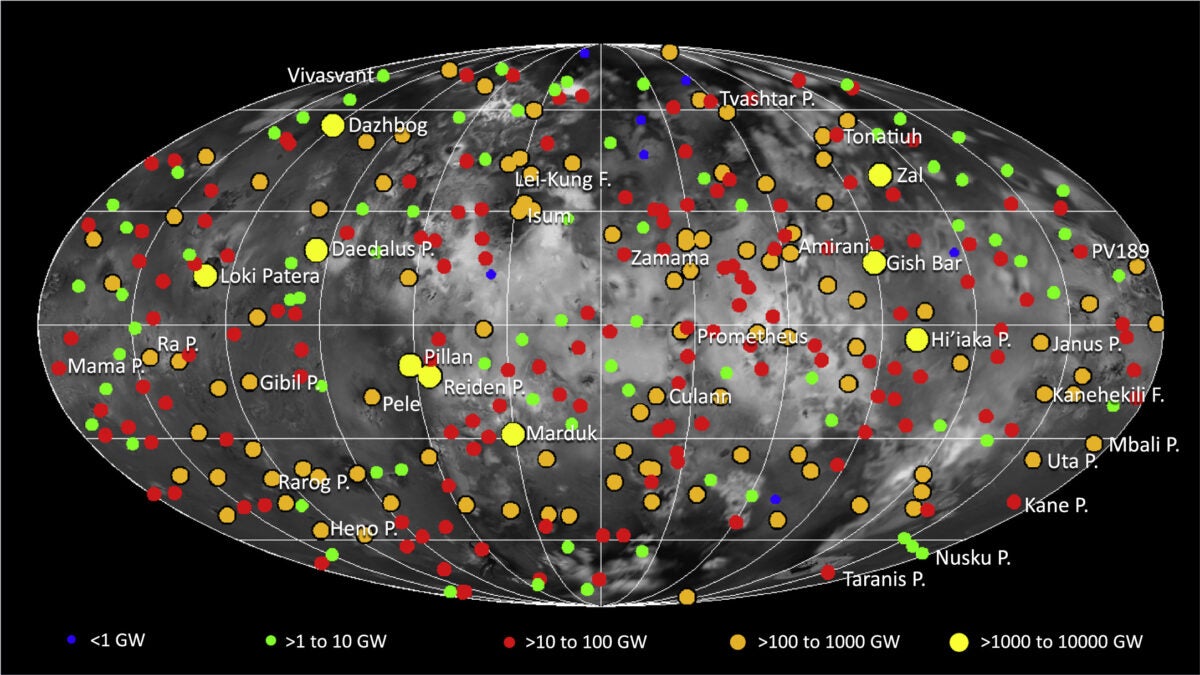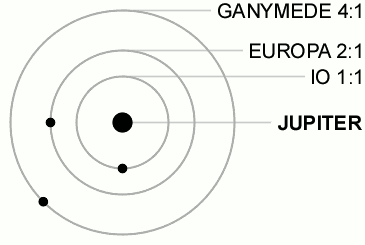
Io, one of Jupiter’s Galilean satellites, is the most volcanically active body in the solar system. Images from spacecraft have shown molten lava erupting along walls that dam giant lava lakes and towering plumes of gas and dust rising from broad calderas.
Now, a team led by planetary scientist Ashley Davies at NASA’s Jet Propulsion Laboratory has prepared the first global heat flow map of Io’s volcanic activity. The new map shows the locations where magma has erupted from the moon’s interior. The results, published in The Planetary Science Journal, point to a possible magma ocean in the satellite’s interior and highlight how common resonances in the orbits of celestial bodies could lead to other oceans in the solar system and beyond.
Related: Io has likely been active for our solar system’s entire history
Put your thermal goggles on
The team found 87 previously unknown hot spots using data from NASA’s Juno spacecraft and an additional 14 such sites from data collected with ground-based telescopes. They combined the new sites with those previously known to map a total of 343 sources of volcanic activity on the moon.
The results show, for the first time, that Io’s volcanoes are evenly distributed on a global scale, but that the heat they emit is not. Volcanoes in the polar regions emit less heat than those at lower latitudes. Further, Io’s northern polar volcanoes release twice as much energy as those in the southern polar region. “That was the biggest surprise,” says Davies — “a real puzzle that we haven’t got to the bottom of yet.”
The uneven distribution of heat, with more at mid-latitudes than the poles, is consistent with models that suggest heating in Io is occurring closer to its surface and melting subsurface rock. However, Davies says that it isn’t clear how extensive the melt would be: “We don’t know if that is a global magma ocean or [a] partial one.”
Tidal heating

One of the reasons Io is so volcanically active is that the moon is caught in a repeating pattern of orbital configurations, called orbital resonances, with two of Jupiter’s other satellites, Europa and Ganymede. In particular, Europa takes twice as long to orbit Jupiter than Io, and Ganymede takes four times as long as Io. Due to these resonances, the moons experience regularly repeating gravitational tugs from each other during alignments, which has made their orbits less circular. Hence, because Io gets closer to and farther from Jupiter during each revolution, the tidal forces stretch and squeeze the moon, producing heat.
“The tidal forces create friction,” says Giacomo Lari, a mathematician at the University of Pisa in Italy and first author of another recent paper on Jupiter’s moons, published in Celestial Mechanics and Dynamical Astronomy. And because Jupiter is so massive and Io orbits so close to the planet, the resulting tidal heating is extreme. The effect is diminished but still present on Europa, whose orbit has become less circular and also undergoes tidal heating, potentially enabling a water ocean to exist beneath its icy crust.
Jupiter isn’t the only place where such effects matter: Saturn’s moon Enceladus is also thought to have a water ocean, which may be sustained by tidal heating caused by resonances with the moon Dione.
“Understanding how resonances work and how the resulting activity has affected these incredible moons is of vital importance to understanding the evolution of the solar system,” says Davies. This also includes the history of volcanism on Earth, the Moon, and Mars, which likely experienced activity similar to the scale of Io early on, adds Davies.
Three isn’t a crowd
Lari’s paper showed that the orbits of Io, Europa, and Ganymede are dominated by the combined interaction of all three bodies, rather than separate resonances between pairs of moons — a finding that was not necessarily obvious, says Lari.
He adds that the three moons are currently in a “safe zone” where the resonances are stable, and should continue to be for at least a billion years. Considering that this three-body resonance is the only one known between moons in the solar system, the opportunity to observe the tidal effects is extraordinary.
And the effects go far beyond our solar system as well. Astronomers have discovered exoplanetary systems where several major planets orbit in resonant chains. In the future, perhaps researchers could examine such systems — or a system of exomoons around a single exoplanet — for similar hot spots that could indicate tidal heating and the formation of magma or water oceans.
And in the meantime, the new results at Jupiter will certainly keep researchers anticipating more.









